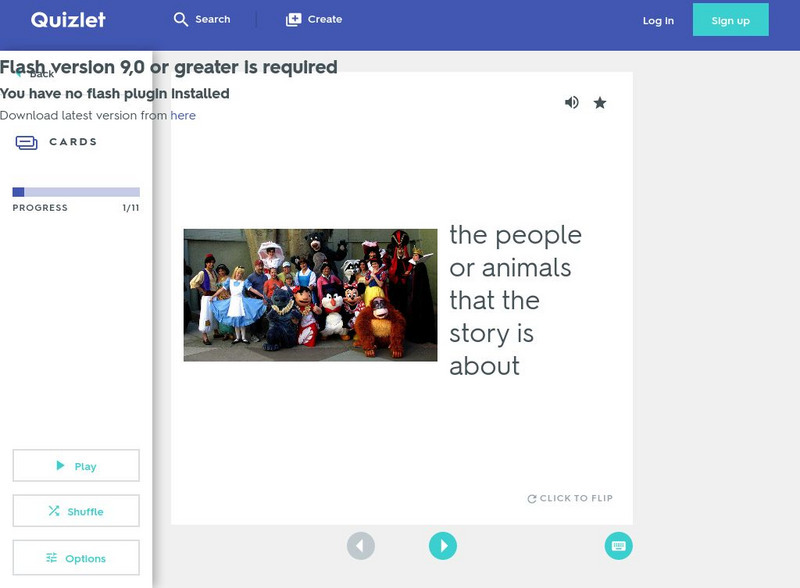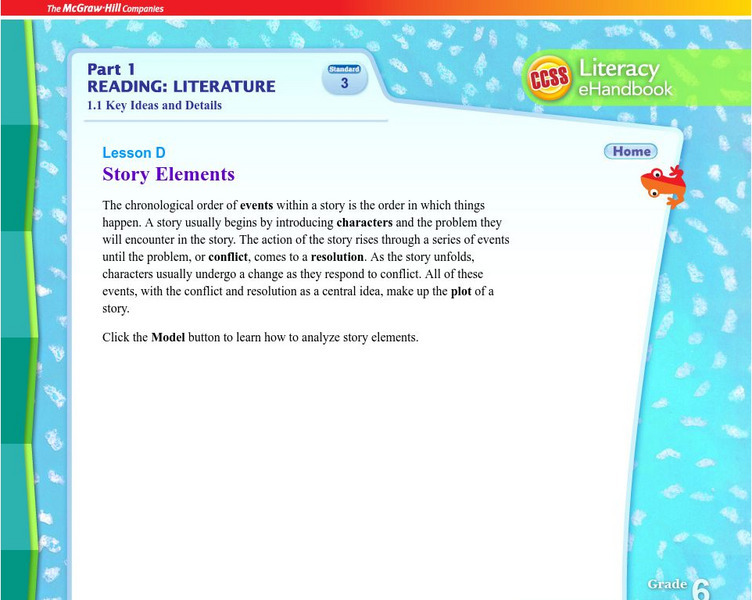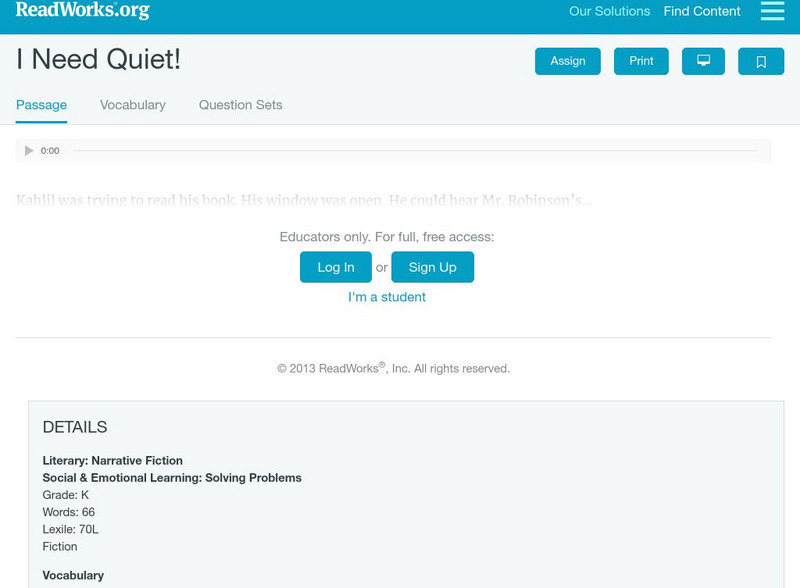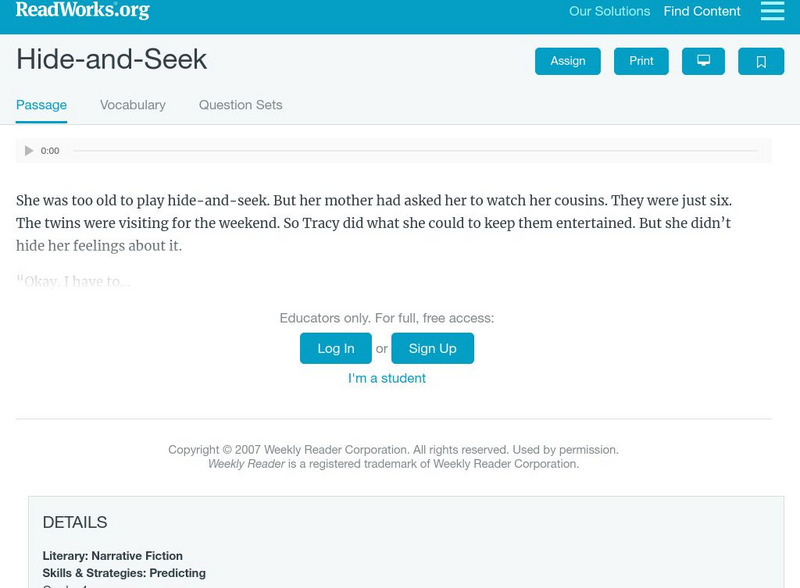Quizlet
Quizlet: Story Elements (1St Grade): Flashcards
These interactive flashcards provide definitions for different story elements. Engaging picture cues are provided for each flashcard, and students can play the audio to hear the words and definitions read aloud.
Quia
Quia: Compare/contrast Character, Plot, and Setting Test
This interactive activity assesses students' understanding of the story elements. Students will read passages that include a short story and a brief drama; then students will answer assorted questions associated to each piece.
ClassFlow
Class Flow: Story Elements
[Free Registration/Login Required] This flipchart defines the elements of a story: character, setting, theme, and conflict.
Quizlet
Quizlet: Story Elements Quiz: 6th Grade Honors: Flashcards
These interactive flashcards provide definitions for different story elements.
Quizlet
Quizlet: Story Elements Quiz 6th Grade Honors Gravity
This interactive game of "Gravity" assesses students' knowledge of story element definitions. Students will match the correct story elements to their corresponding definitions.
Curated OER
Mac Millan: Story Elements: Grade 6
This learning module focuses on analyzing story elements including the order of events, character, conflict, resolution, and plot. It provides a model story with questions and answers and then a practice story with questions.
Houghton Mifflin Harcourt
Holt, Rinehart and Winston: Elements of Literature: Determining Methods of Characterization [Pdf]
A brief organizer in which students can document how a character in literature is presented, through either direct or indirect characterization. Provides labels, examples, and sections for textual support.
Department of Defense
Do Dea: Story, Identity, Unity
Delve into the art of storytelling in this self-guided unit. Multiple topics are covered such as literary genres, the 7 elements of fiction, figurative language, theme, characterization, etc. At the end of the unit, write your own flash...
PBS
Pbs Learning Media: Nature Cat: Story Exploration Packet
As you watch Nature Cat, use these tools to guide discussions and learning activities. Includes printables on story elements, alternate endings, vocabulary words, character traits, an episode map, and a Venn diagram.
ReadWriteThink
Read Write Think: Fairy Tales From Life
A guideline for helping students to write their own fairy tales. This is a fun activity that will help students to analyze a literary style and follow a pattern.
Annenberg Foundation
Annenberg Learner: Characters
Learn about the different types of characters in Cinderella, and determine which traits belong to the hero and villain. Click on the "Character" button.
ReadWriteThink
Read Write Think: Reader Response in Hypertext: Making Personal Connections
Young scholars write a narrative of place, a character sketch, an extended metaphor poem and a persuasive essay then link all four texts to quotations they have selected from a novel.
TES Global
Blendspace: Interpreting Literature Terms
A fourteen-part learning module on literary terms including links to text, videos, word lists and images on literary terms such as plot, setting, character, point of view, style, theme, and more.
Other
Short Story Elements
Geared toward high school students, this site contains many notes and links on the aspects of short story, figurative language, and figures of speech.
Alabama Learning Exchange
Alex: Using Fairy Tales to Teach the Short Stories
Familiar fairy tales are used as guides to help students analyze the elements of the short story: plot, theme, setting, point of view, and character.
Polk Brothers Foundation Center for Urban Education at DePaul University
De Paul University: Center for Urban Education: Why Did Mamma Change Her Mind? [Pdf]
"Why Did Mamma Change Her Mind?" is a one page, fictional, reading passage about a party. Mom said her son and daughter could each have 5 friends (5 boys and 5 girls). The girl wanted all girls so the party was cancelled. It is followed...
Read Works
Read Works: I Need Quiet!
[Free Registration/Login Required] A literary text about a boy named Kahlil who figured out a way to eliminate noisy distractions so he could read. A question sheet is available to help students build skills in reading comprehension.
Read Works
Read Works: Hide and Seek
[Free Registration/Login Required] A literary text about a girl named Tracy who played hide and seek with the cousins she was babysitting. A question sheet is available to help students build skills in reading comprehension.
PBS
Pbs Learning Media: Nature/national Geographic: Flora's Background and Motivation
Learn about what motivated Flora, a woman from the city, to move to the African bush in this short video from Nature/National Geographic. This is one in a series of three videos about Flora's life. [7:00]
Other
America Dept. Of State: Outline of American Literature [Pdf]
This online book presents an overview of American literature chronologically. Eras and movements are explained and biographies of significant authors are provided. This is a good way to understand the background and influences of...
Alabama Learning Exchange
Alex: Using Digital Notebook to Visualize Thematic Links
Students will work in groups of two or three to produce two pages of a digital scrapbook covering a thematic element from Macbeth. The pages will then be assembled into a visual review of the play's themes and character motivations...
Universal Teacher
Moore's Teacher Resources: Studying Macbeth
A site from the UK on William Shakespeare's Macbeth. Complete with information on the historical context, character analysis, thematic elements, and review questions.
Other
Writing World: Four Ways to Bring Settings to Life
A great resource outlining four major ways to make settings appear more real and genuine in fiction. Deals with themes such as motion, experience, mood, and the senses. W.11-12.3d Sensory/precise lang narratives
Reading Rockets
Reading Rockets: 103 Things to Do Before/during/after Reading
The highly-respected Reading Rockets program offers both teachers and students a toolkit of ways to connect more actively with the materials they read. Some of these techniques are specifically for fiction-reading, others are designed...








![Holt, Rinehart and Winston: Elements of Literature: Determining Methods of Characterization [Pdf] Graphic Holt, Rinehart and Winston: Elements of Literature: Determining Methods of Characterization [Pdf] Graphic](http://content.lessonplanet.com/resources/thumbnails/410109/large/bwluav9tywdpy2symdiwmduymc0ymjy4mc0xz3pvamf3lmpwzw.jpg?1589985471)









![America Dept. Of State: Outline of American Literature [Pdf] eBook America Dept. Of State: Outline of American Literature [Pdf] eBook](http://content.lessonplanet.com/resources/thumbnails/410155/large/bwluav9tywdpy2symdiwmduymc0yotc0ny0xzhf5cgiwlmpwzw.jpg?1589985629)



